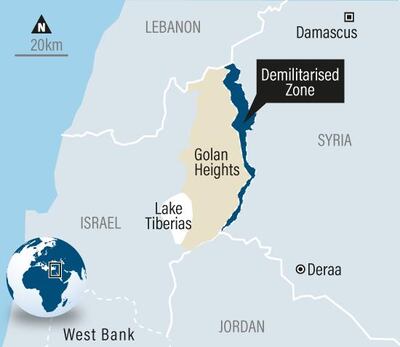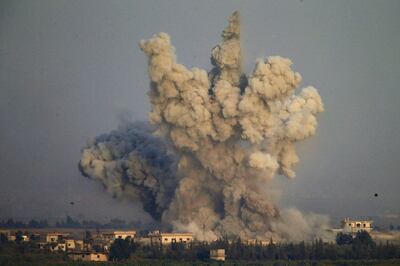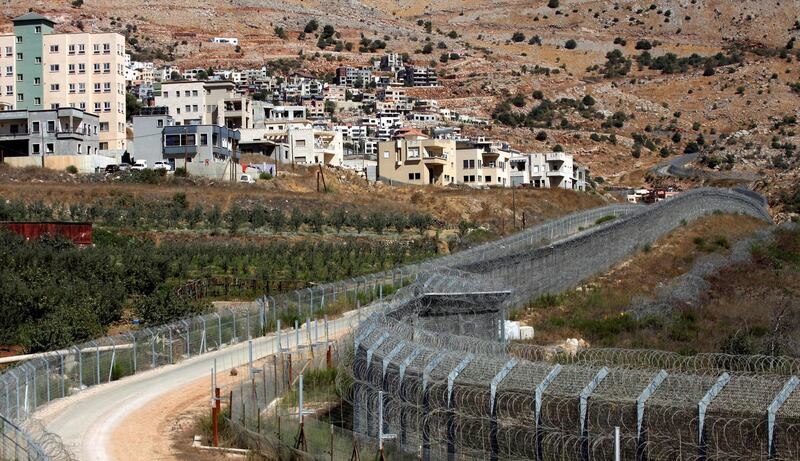In the occupied Golan Heights, roads wind ever upwards between green orchards heavy with apples.
Brown signposts to Israeli tourist sites abound. To the left is a protected area surrounding a Crusader-era castle. Up ahead, yellow gates mark the entrance to Neve Ativ settlement, where a plastic snowman stands incongruously in the sunshine.
But signposts to the few remaining Syrian villages in the area are scant. Eventually, an arrow points in the direction of Majdal Shams, the largest of four communities left after Israel captured the Golan Heights from Syria in the 1967 Six Day War. Having destroyed 340 villages and farms, Israel annexed the strategic and fertile land in 1981 — a move never recognised internationally.
For a long time, the Golan was Israel’s quietest front — UN forces patrol a buffer zone between the annexed land and Syria — and in 1974 the enemy states signed a disengagement agreement.
But since the Syrian conflict began more than seven years ago, the people who live here, many of whom follow the Druze faith, have walked on shakier ground. Tensions have escalated further this year, and after launching a military campaign in June, the Syrian army and its allies control all land up to the UN patrolled zone.
That has prompted Israeli fears that Iran-backed militias will stock weapons on the front, in a similar manner to Hezbollah in southern Lebanon near the border.
__________
Read more:
Israel shoots down Syrian jet near Golan Heights
Syrian regime forces close in on area near Israeli-annexed Golan Heights
__________
Syrian activists in the occupied Golan believe Israeli authorities have taken advantage of Syria's war to tighten their grip on the area.

Having increased by a third since 2011, the number of Israeli settlers in the region now roughly equals the 25,000-strong Syrian population. The 34 illegal settlements such as Neve Ativ, along with the military and other authorities, control 95 per cent of the land.
"In these past seven years, they launched a lot of important projects, in the sense of brainwashing the young generations," said Wael Tarabieh, an artist and cultural rights programme manager at Al Marsad — a local organisation documenting human rights violations.
"There was a scouts movement launched in the villages. It has been working in the Galilee for a long time, but in recent years they have been establishing these movements here in the Golan too."
Like communities in the occupied West Bank, Syrian residents of the Golan face throttled land access, building restrictions and property destruction. Majdal Shams is a tight cluster of breezeblock and concrete buildings criss-crossed with wires and peppered with water tanks.
"It is best described as two opposite worlds — if you look at the illegal Israeli settlements they have low-rise housing with gardens and lots of common green spaces," said an Al Marsad colleague of Tarabieh, on condition of anonymity. "The Israeli authorities refuse permission for Syrians to build beyond the village boundaries."
Settlers' modern homes incorporate bomb shelters, but Syrians in the area face significant restrictions on adding to older houses. Even as exchanges of missile fire between Israel and Syria can sometimes be heard from Majdal Shams, Tarabieh is among the residents without a shelter.
"People are afraid for their lives when there are missiles and bombing," he told The National. "We are in the eye of the storm — here is calm but everything is going on around us."
There are also Israeli army bases around the Syrian villages, including one built in 2016 above Majdal Shams.
The IDF maintains that its presence in the Golan protects all citizens within Israeli borders, and that military posts are meant to defend not harm them. It uses the territory for military manoeuvres and monitors events on the Syrian side of the UN buffer zone.
But campaigners from groups such as Al Marsad say that landmines around the military posts pose a risk to residents, while farmers often find themselves cultivating ground alongside some of the Golan’s 2,000 minefields. To complicate things further, the area’s Syrian community has also been sharply divided since 2011 between supporters and opponents of President Bashar Al Assad.

Some vehemently oppose his rule, and are keen to make it clear that their opposition to Israel’s Golan annexation does not equal support for the government in Damascus.
"I have a thousand reasons to reject the Israeli occupation but here I have freedom and do not have the fear of arrest," said 47-year-old Hassan Shams, an editor and writer from Majdal Shams, as he described writing anti-Syrian government reports. “I can reject both disgusting systems. I am not with either."
Other Syrians in the Golan support President Assad's rule, and the divisions have led to violence.
After he came out in support of the Syrian revolution in 2011, 63-year-old Mahmoud Amasha was attacked by supporters of Mr Al Assad. The farmer and insurance manager recalls the incident in his ground floor office in the Golan village of Buqa’ata. He still walks with a limp.
"One day, they arrived with lots of cars," he told The National. "I went out and asked them, 'What do you need? If you need coffee, come and I will offer it to you'. They looked at me with ridicule and said, 'Your coffee is unacceptable'. I approached them to talk with them, and as I reached the third car, another came behind me and hit me."
The incident, for which no one was convicted, left Mr Amasha in hospital for 20 days. Since then, he says, tensions between the Golan’s pro- and anti-Assad groups have eased.
That may stem in part from Syrians’ dismal realisation that the status quo is likely remain.
"Syrians have become desperate after the destruction and atrocities they witnessed," said Mr Tarabieh. "The Syrians themselves inside Syria became calm because there will not be any winner. And here it is the same."
Concerned over an Iranian military presence on the Golan front, Israel is not likely to lose control of the contested territory at any time soon. Observers doubt whether Russian proposals to keep Iran-backed forces away from the UN boundary can be honoured.
While Israel attempts to fend off regional enemies, the Golan’s minority Syrian community feels ever more marginalised. A fine statue in the centre of Majdal Shams commemorates Sultan Pasha Al Atrash, who led the Great Syrian Revolt against colonial forces in the 1920s. There is no brown tourist sign pointing towards it.





